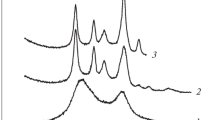Summary
Single crystals of various two block copolymers of poly(ethylene oxide) (PEO)-polystyrene (PS) were examined electronmicroscopically with examples of pure poly(ethylene oxide) included. These copolymers crystallise in the form of square tablets or long strings of layers, the latter breaking up into square shaped multilayer crystals often consisting of twisted spiral terraces.
Electron diffraction patterns confirmed that the lattice is that of PEO. This result in combination with layer thickness measurements from electronmicrographs and by low angle X-rays is in agreement with the suggestion made previously that the crystal platelets consist of chain folded crystalline PEO sandwiched between amorphous PS. A variety of habit features were observed amongst the single tablet crystals equally characteristic of the copolymers and of the PEO homopolymer. In particular, twinning effects were detected and interpreted, which amongst others aided the elucidation of anomalies in the electron diffraction patterns of pure PEO found earlier.
Examination of the crystal tablets revealed various kinds of sectorisation effects, striations and crystal halvings, both morphologically and by diffraction selection. In some preparations the tablets were doublets, with the PEO components in perfect atomic register suggesting regular fold surfaces in contact within these doublets.
Some new observations made on the multilayer aggregates promises to be of general validity in polymer crystal growth. In particular, the string of layers result from growth initiated by a connected line of nuclei.
Zusammenfassung
Einkristalle von verschiedenen Bloek-Copolymeren aus Polyäthylenoxid (PE) und Polystyrol (PS) wurden elektronenmikroskopisch zusammen mit Proben aus reinem Polyäthylenoxid geprüft. Diese Copolymeren kristallisieren in Form von quadratischen Tafeln oder langen Streifen von Schichten. Letztere zerbrechen in quadratisch geformte Vielschichten-Kristalle, die oft aus spiralisch verdrehten Stufen bestehen.
Elektronen-Beugungsaufhahmen sichern, daß das Gitter das des PEO ist. Dieses Ergebnis in Verbindung mit Messungen der Schichtdicke aus Elektronenaufnahmen und Kleinwinkelbeugung ist in Übereinstimmung mit der früheren Vermutung, daß die Kristallblättchen aus kettengefalteten PEO-Kristallen als Sandwiches zwischen amorphem Polystyrol bestehen. Eine Vielzahl von Zügen des Habitus wurde bei den einzelnen Tafel-Kristallen beobachtet, gleich charakteristisch für Copolymere und für PEO-Homopolymere. Insbesondere wurden Effekte der Zwillingsbildung entdeckt und interpretiert, welche u. a. halfen, die früher gegebenen Erklärungen von Anomalien bei der Elektronenbeugung von reinem PEO zu klären.
Die Prüfung der Tafel-Kristalle ergab verschiedene Arten von Unterteilungseffekten, Streifung und Kristallunterteilungen, sowohl morphologisch als auch durch selektive Streuung. Bei einigen Präparationen waren die Tafel-Doubletten hinsichtlich der PEO-Komponente in vollkommen regelmäßiger Atomanordnung, was auf reguläre Faltenoberflächen im Kontaktbereich mit diesen Doubletten schließen läßt.
Einige neue Beobachtungen an Vielschicht-Aggregaten scheinen allgemein für Polymer-Kristall-Wachstum Gültigkeit zu haben. Insbesondere ist die lineare Anordnung von Schichten das Ergebnis aus einem Wachstum, initiiert durch eine Kette von Keimen.
Similar content being viewed by others
References
Lotz, B. andA. J. Kovacs, Kolloid-Z. u. Z. Polymere209, 97–114 (1966).
Baltá Calleja, F. C. andA. Keller, J. Polymer Sci. A2, 2171 (1964).
Baltá Calleja, F. C., Ph. D. Thesis, Bristol University (1962).
Baltá Calleja, F. C., I. L. Hay, andA. Keller, Kolloid-Z. u. Z. Polymere209, 128–135 (1966).
Price, F. P. andR. W. Kilb, J. Polymer Sci.37, 395 (1962).
Richards, J. R., Dissertation Abstracts22, 1029 (1961).
Tadokoro, K., Y. Chatani, T. Yeshihara, S. Tahara, andS. Murahashi, Makromol. Chem.73, 109 (1964).
Barnes, W. J. andF. P. Price, Polymer5, 283 (1964).
Keller, A. andS. Sawada, Makromol. Chem.74, 190 (1964).
Frank, F. C., A. Keller, andA. O'Connor, Phil. Mag.4, 200 (1959).
Keller, A., Phil. Mag.6, 329 (1961).
Bassett, D. C., F. C. Frank, andA. Keller, Phil. Mag.8, 1753 (1963).
Bassett, D. C., R. F. Dammont, andR. Salovey, Polymer 5 (1964).
Blackadder, D. A. andH. M. Schkinitz, Nature200, 778 (1963).
van der Heide, H. B., Nature199, 798 (1963).
Bassett, D. C. andA. Keller, Phil. Mag.7, 1553 (1964).
Geil, P. H., Polymer Single Crystals, Interscience (1963).
Keller, A., Polymer3, 393 (1962).
Pennings, A. J., Private communication: also Preprint No. 216 of I.U.P.A.C. Symposium on Macromolecules (Prague 1965).
Author information
Authors and Affiliations
Rights and permissions
About this article
Cite this article
Lotz, B., Kovacs, A.J., Bassett, G.A. et al. Properties of copolymers composed of one poly-ethylene-oxide and one polystyrene block. Kolloid-Z.u.Z.Polymere 209, 115–128 (1966). https://doi.org/10.1007/BF01500629
Received:
Issue Date:
DOI: https://doi.org/10.1007/BF01500629




